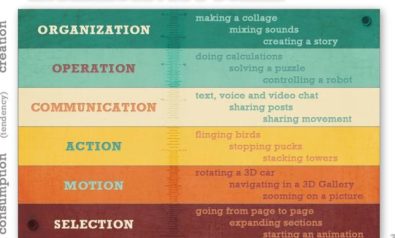Dan Zen on consumption and creation. It’s A Consumer's World We have seen a difficult trend for independent interactive content creators: Fifteen years ago content creators were paid for creating content. Ten years ago creators were downgraded to receiving advertising money. Five years ago creators had to pay to have their content shown. Today, content creators have to pay consumers to partake in their content. This, of course, is a generalization, but in the digital world the contemporary consumer seems to get what they want at very little cost. They now assume that music, entertainment and information should be (and there are often ways to get it) free. This however makes it tough for creators of original content to make a living and to optimally produce content. For instance, my own site http://danzen.com has 3 million page views. At a minute a view this is 50,000 hours of entertainment. And yet, from dozens of different attempts at monetizing, the site has made about $500. That is a payoff of one cent an hour. The concern, however, is not just the money -- interactive content creators are often happy if people simply use their tools or experience their environments. A far greater concern is that people are partaking less and less in independent interactive content. "Interactivity" can be broken down into types and when referring to interactive content I mean interactivity beyond just navigation to where people can create and communicate with one another. People today are spending increasing amounts of their time on YouTube, Facebook and Twitter Here, they share pictures, stories and videos that comprise authorative content, but they rarely share interactive content or take the time to go out and engage in interactive experiences. We can deduce that the attention span of people online has been greatly reduced. They write and read in 140 characters. The status post is the new blog. They are no longer accustomed to spending time reading a story, let alone creating a story. Alongside social media usage, people are increasingly partaking in online gaming. For the most part, gaming is consumption of thrill and is not really creation. Puzzles have the mindset of creation and they hone the mind of the user but the output does not benefit society. Creation via programming also hones the mind, and has the added benefit that the output usually helps society: it educates or entertains and can provide environments to communicate or organize. On a positive note, today there is more creative practice executed in a day than in all of history up to 1950. Millions of songs, art pieces, stories and the like are being made on a daily basis. Proportionally, though, I think less people create. This is probably because there is just so much to consume and to consume is so much easier. Also, creative renaissances come and go, just like any other trend. Those trends may also differ in different regions. I would not say that in North America it is currently "popular" to create although the Maker movement is gaining traction. Creation and Mobility A recent factor in the creation versus consumption balance has been the onset of mobile devices. Smaller mobile screens and somewhat reduced controls can limit creative production. For instance, graphic designers use many panels in an application such as Photoshop and require precise selections that would be hard to achieve on a mobile device. Even if the interfaces improve, there is often distraction when being mobile, especially in busy areas, and so surely this is not the correct platform for true creativity. Even so, workstations, the ideal site for focused creativity, are being abandoned for mobile devices. Naming Interactivity People gravitate towards things they are comfortable with. The Internet is a new medium - even more so a medium of mediums - and yet the majority just use it to consume articles, listen to music, view pictures, watch videos and play games. These mediums are easily recognized with single established names and the user has clear expectations before partaking. We do not have a name for a digital interactive feature. We may call it a tool or an application, but this is far from suiting all interactive features. Could we call it an environment or medium instead? Perhaps, but these categories seem a bit broad. If we had a specific made-up name for an interactive piece, project or feature then perhaps there would be more support for sharing and partaking in it because people will instantly understand what is offered. For instance, Neal Stephenson in The Diamond Age calls them "Ractives". Interactivity and Personal Growth From a personal growth standpoint, we have been led by accountability concerns towards only being our "legal" self. The opportunity to explore personas to interact with abandon has been greatly reduced and marginalized. For instance, we are required by policy to be only ourselves on social media sites such as Facebook - any other personas are removed or at least viewed with suspicion. This is a shame. There needs to be more opportunity to interact with imagination and passion - not just in second life or dating sites but in our average every day life. A site such as http://hipcats.com, allows you create personas and interact with others , making it possible to explore new ways of thinking and acting which may actually lead to real life transformation. Slowing Down in Conclusion It would be great if people slowed down a little and spent more time thinking and creating. The Internet is a wonderful medium to favour creative collaboration. Perhaps exploring fresh personas would give people a better ambience for creation and help tip the world back to a healthy balance. If your character is an artist or inventor, then you might realize -- hey... I can be an artist or inventor! Creative writing can often lead to self-transformation and even invention. I suspect that I am preaching to the converted. If you feel the same way and want your friends to know, please share the article!
Support Fair Observer
We rely on your support for our independence, diversity and quality.
For more than 10 years, Fair Observer has been free, fair and independent. No billionaire owns us, no advertisers control us. We are a reader-supported nonprofit. Unlike many other publications, we keep our content free for readers regardless of where they live or whether they can afford to pay. We have no paywalls and no ads.
In the post-truth era of fake news, echo chambers and filter bubbles, we publish a plurality of perspectives from around the world. Anyone can publish with us, but everyone goes through a rigorous editorial process. So, you get fact-checked, well-reasoned content instead of noise.
We publish 2,500+ voices from 90+ countries. We also conduct education and training programs
on subjects ranging from digital media and journalism to writing and critical thinking. This
doesn’t come cheap. Servers, editors, trainers and web developers cost
money.
Please consider supporting us on a regular basis as a recurring donor or a
sustaining member.
Will you support FO’s journalism?
We rely on your support for our independence, diversity and quality.








Comment